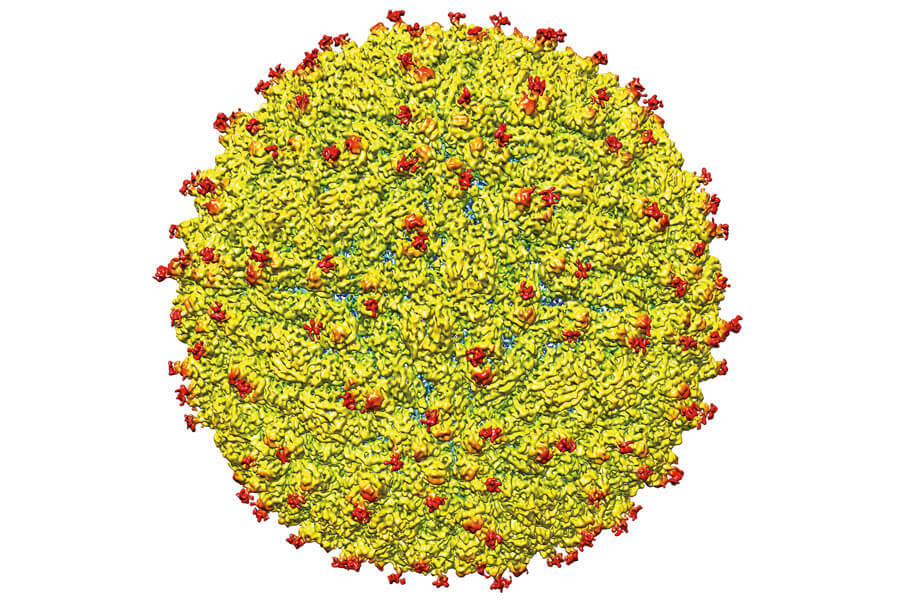
Purdue research is aimed at detecting and monitoring mosquito-borne diseases faster and more cheaply than current methods, to aid in preventing virus outbreaks and their devastating effects.
Lia Stanciu-Gregory, associate head and professor of materials engineering, is leading the research and development of the technology. Additional researchers are Ernesto Marinero, professor of materials engineering and electrical and computing engineering; and Richard Kuhn, the Trent and Judith Anderson Distinguished Professor in Science, in the Department of Biological Sciences, and Krenicki Family Director of the Purdue Institute of Inflammation, Immunology and Infectious Disease. Kuhn and Michael Rossman, the Haley Distinguished Professor of Biological Sciences, led a research team that was the first to determine the structure of the Zika virus utilizing cryo-electron microscopy, a technology that allows scientists to see complex biological specimens, including viruses, at almost atomic-scale resolution.
“Over one billion people around the world suffer from one or more neglected tropical diseases (NTDs),” Marinero says. “These diseases, such as dengue fever, yellow fever and the West Nile virus, are classified as NTDs because they largely affect poor populations in the developing world and are a low public health priority for developed continents like North America and Europe.
He adds: “NTDs, as well as the Zika virus, are transmitted by vectors such as mosquitoes and ticks. Climate change and an increase in travel are causing these types of diseases to steadily spread around the globe, which increases the need for better monitoring and detection methods to help prevent outbreaks.” Stanciu-Gregory says that current detection methods for NTDs are often time-consuming, expensive and complicated.
“Laboratory techniques that detect viruses aren’t very efficient and require patients to go to a hospital and wait some time for their results, which isn’t always possible in developing countries,” she says. “By the time people realize they need to start monitoring a disease, it’s often too late and an outbreak has emerged. We want our technology to be able to be the first to detect and monitor a disease, so that preventive measures can be taken to avoid or lessen the effects of devastating outbreaks.”
Stanciu-Gregory, Marinero and Kuhn have developed an amperometric biosensor that utilizes functionalized nanoparticles that specifically bind to the target viruses’ DNA or RNA. When the binding occurs, there is a change in the device resistance, which the sensor employs to unambiguously detect the presence of the virus. The sensor can then determine whether or not a blood or mosquito sample has the virus and how much of the virus is present. The sensor relies on an agent that will only respond to the intended virus to be detected.
“We’ve used mosquito samples on our laboratory scale sensor, and we’ve been able to detect the virus showing a high-sensitivity rate to low concentrations of the virus,” Stanciu-Gregory says. “We’ve been especially interested in the dengue and Zika viruses because it’s the same mosquito that transmits both diseases, so our technology would be able to quickly detect one of those diseases using the same platform.”
Marinero says there are many ways in which they plan to further develop their device.
“Our first and foremost goal is to have a point of care, potentially a personal device, which is simple to use. This would allow people to detect the virus promptly without having to go to a hospital, which would have significant impacts in developing countries,” he says. “However, we’re also working on an autonomous device in remote field areas that are difficult to access or where it is difficult to perform in-site detection.”
The device will operate through a low-power wireless network and will use thin-film rechargeable batteries combined with thin-film photovoltaics to power and harvest energy from the environment to maintain functionality and performance without human intervention. When a disease is detected in a mosquito sample, it will send an alert to health control officials about the potential threat.
Stanciu-Gregory says they are seeking funding to further develop the technology.
“At this point we’re satisfied with our technology meeting its objectives in the lab, and we are ready to begin prototyping,” she says. “Funding will allow us to develop the autonomous capabilities, so the device can be deployed remotely. With the Zika outbreak and other mosquito-borne viruses becoming even more prevalent, we think building a platform of biosensors that uses a chip to detect a variety of viruses in one device can make a real difference in mitigating the spread of such diseases and help people across the globe.”



